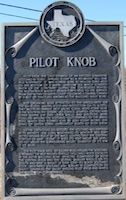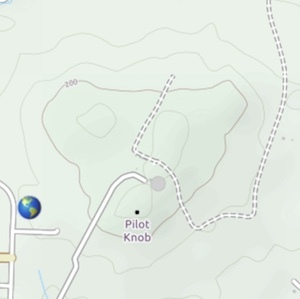|
This earthcache will make you discover a relatively unknown feature of Central Texas: extinct volcanoes.
Don't go to the posted coordinates!
The posted coordinates are the original coordinates where a Texas Historical Marker for Pilot Knob used to stand. Unfortunately it was destroyed in 2010.
The new instructions will get you to a park on the slope of the Volcano. See the waypoints below.
|
 |
Pilot Knob, a Volcano
Definition
A volcano is an opening, or rupture, in a planet's surface or crust, which allows hot, molten rock, ash and gases to escape from below the surface. |
Pilot Knob’s Formation and Erosion
Imagine Central Texas 80 million years ago. The area around Austin was underwater in a warm shallow sea. As the Balcones fault zone was active, fractures appeared at the bottom of the sea causing magma to come up in contact with sea water. The water was nearly instantly vaporized into steam causing explosions, releasing ashes. Gradually, a mound of ashes was built up over the explosion crater, growing eventually above sea level. Subsequently, the magma that came above sea level did not cause ash explosions and was able to cool and solidify creating the core of the volcano.

Over time, as the volcano activity subsided, beaches were created around the mound, coral and other shellfish settled on the slopes of the volcano.
Once the sea that covered central Texas disappeared, the entire volcano was exposed to erosion, losing a lot of its mass.
Pilot Knob Today

What is left today is a cluster of hills with a water tank on top that dominates the surrounding area by 180 feet. The picture above is from Colton Bluffs Spring road.

Principal component of both the central knob and the several smaller knolls on its south and east is basalt, a dark gray to black volcanic rock. Weathered volcanic ash, similar in composition to basalt, underlies the valley around Pilot Knob and makes the land rich for farming.
Definition
Basalt is an aphanitic (fine-grained) igneous rock with generally 45-53% silica (SiO2) and less than 10% feldspathoid by volume, and where at least 65% of the rock is feldspar in the form of plagioclase. It is the most common volcanic rock type on Earth.
Basalt is usually grey to black in colour, but rapidly weathers to brown or rust-red due to oxidation of its mafic (iron-rich) minerals into hematite and other iron oxides and hydroxides. |
Logging Requirements
Go to the parking waypoint coordinates. They will lead you to Knob Hill park located on the slopes of the volcano
Then proceed on foot to the reference coordinates where you will find a big decorative arc of rocks on the grass next to the trail on the other side of the playground. Take a close look at these rocks.
To confirm the find, please send me the responses to these questions by message or email
|
Question #1: Describe the colors of the rocks. |
|
Question #2: Describe the texture of the rocks. |
|
Question #3: Do you think that they are volcanic rocks? |
|
Optionally attach a picture with your log. You can go up to Lookout Point (see waypoint) for a nice view of the area. The top of the hill to the North East is the rim of the old volcano. Please don't show the rocks on the picture.
Enjoy!
Reference:
